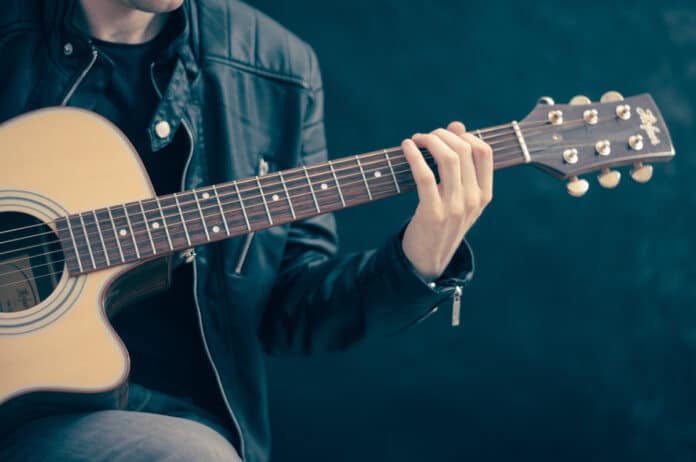
In the pantheon of musical instruments, few match the cultural impact and ubiquity of the electric guitar.
It’s a symbol of rebellion, a tool for emotional expression, and a catalyst for social change. But before we delve into its techniques and intricacies, let’s embark on a journey through its electrifying history.
The Resonating Riffs of History: A Brief Overview
The history of the electric guitar is essentially a chronicle of innovators seeking new ways to make their instruments louder. Though stringed instruments have been around for millennia, the electric guitar is relatively young – it emerged in earnest during the 1930s when George Beauchamp co-created “The Frying Pan”, essentially marking it as an invention that truly rocked the world. The need for more volume in big band orchestras was integral to its birth; however, it was Leo Fender’s mass production strategy in the 1950s that made this instrument accessible to everyday individuals and not just professional musicians.
Rising Above The Crescendo: Importance and Influence in Modern Music
As we traverse through modern music’s soundscape, it’s impossible to ignore how emphatically influential the electric guitar has been. Its versatility has enabled it to straddle genres from rock n’ roll where it’s often seen as an emblematic figure—think Jimi Hendrix setting his Stratocaster aflame at Monterey—to jazz where artists like Wes Montgomery used its mellifluous tones to create complex harmonic structures.
Moreover, beyond being an instrument that creates melody or harmony, it has acted like a rambunctious interloper shattering rhythmic norms with power chords in punk rock or acting as a sonic paintbrush creating ambient landscapes in post-rock ensembles. Its importance isn’t confined merely to being an essential part of music making; instead, its influence lies significantly in how dramatically it changed listening experiences too by introducing distortion or effect pedals which became instrumental in shaping various sub-genres within rock itself.
But what gives this instrument such sway over our cultural zeitgeist? Is it merely about expressing pent-up emotions?
Or does playing guitar involve puzzles that our brains instinctively try solving? As we chart this melodic discourse further into nuances of playing this six-stringed maestro – we’ll realize playing the electric guitar is as much about science as much artistry – therein lies its charm!
Understanding the Basics
Embarking on a journey towards mastering the electric guitar demands not just sheer passion, but a profound comprehension of the fundamental elements that constitute this iconic instrument. Let us explore these rudiments which can be looked at more in depth with online resources such as https://staytunedguitar.com/.
The Anatomy of an Electric Guitar
The electric guitar consists of various integral components, each playing its part in producing the instrument’s distinctive sound. The Body, often made of wood such as alder or mahogany, is where the strings’ vibrations are amplified.
The Neck, usually crafted from maple or mahogany, is designed to accommodate the player’s hand and allow for different playing positions. Atop it lies the Fretboard, featuring metal strips known as frets that demarcate distinct musical notes when the strings are pressed against them.
The Headstock, situated at the end of the neck, features tuning pegs to adjust each string’s tension and hence its pitch. Equipped with magnetic coils known as pickups (single-coil or humbuckers), an electric guitar converts string vibrations into electrical signals which are then transferred via a cable to an amplifier for projection.
Diversity in Electric Guitars: Solid Body, Semi-Hollow Body, Hollow Body
The world of electric guitars is immensely diverse with distinct types catering to different sound aesthetics and playing styles. A Solid Body guitar contains a solid piece of wood for its body ensuring maximum sustain and distortion capabilities – ideal for rock music enthusiasts.
A Semi-Hollow Body features a central wooden block encased by hollow ‘wings’, providing a blend between hollow-body warmth and solid-body sustain – perfect for blues or jazz aficionados. A fully Hollow Body mirrors traditional acoustic guitars by housing a completely hollow interior generating natural resonance – favored by jazz musicians seeking that authentic vintage tone.
Guitar Terminology: Deciphering Frets, Chords, and Scales
Cultivating familiarity with some basic guitar terminologies can accelerate your learning process substantially. A Fret refers to each metal strip running across your fretboard – pressing down on these will alter your string’s pitch creating different notes.
A combination of several notes played together forms a chord; many popular songs can be played using just three or four basic chords like G major, C major, D major etcetera – referred to as open chords due to their inclusion of open (unfretted) strings. Scales, on another note (pun intended), are sequences of musical notes in ascending or descending order – they form melodic building blocks behind solos and melodies; one commonly used scale among beginners is ‘The Minor Pentatonic Scale’ owing to its versatility across genres like rock and blues.
Getting Started with Your Electric Guitar
Your First Six-String: Selecting the Ideal Electric Guitar
Choosing your first electric guitar can feel like an intimidating task given the sheer variety of makes and models available. However, there are a few key factors to consider that can help guide your decision. Firstly, comfort should be a top priority; ensure that both the size and shape of the guitar are suitable for your body type.
Secondly, pay attention to the quality of components such as tuners, bridges, and pickups as they significantly impact sound quality and stability. While aesthetics do matter, they shouldn’t supersede function or comfort in importance.
Amping Up: The Crucial Role of Amplifiers
The importance of a good amplifier cannot be overstated in the realm of electric guitars. Amplifiers don’t merely make your guitar louder — they dramatically influence sound quality and character.
In essence, an amplifier is integral to shaping your unique sonic signature. Several types exist including tube amplifiers known for warm tones ideal for blues or classic rock; solid-state amplifiers with crisp clarity perfect for jazz or pop; hybrid amplifiers offering a blend of tube warmth and solid-state definition; and modeling amplifiers providing versatile digital sound options perfect for experimental genres.
Mandatory Paraphernalia: Essential Accessories for Your Electric Guitar
Equipping yourself with essential accessories is key to ensuring an optimal playing experience. Picks come in various sizes and materials which affect attack tone – beginners may prefer medium picks for their versatility.
A strap adjusts to hold your guitar comfortably against your body when standing – choose one that spreads the weight evenly over your shoulder. Cables connect your guitar to the amplifier; ensure you select cables with sturdy jacks that provide good signal integrity without noise interference.
Basic Techniques: The Foundation of Electric Guitar Mastery
The Grace of a Guitarist: Holding Your Guitar and Pick Properly
The comfort and ease with which you straddle your electric guitar can greatly affect the quality of your play. Hold it firmly yet tenderly, as though cradling an infant in your arms.
The fretting hand, typically the left hand for right-handed players, grips the neck while the thumb rests gently against the back. With fingers curving over to press down on the strings, they form chords or notes on individual frets.
Meanwhile, your strumming hand balances against the body’s edge, delicately grasping a pick between your thumb and index finger. This is referred to as a standard grip; however, there are variations such as pinch grip or cross grip depending upon personal comfort and style.
In Tune with Harmony: Tuning Your Electric Guitar
Tuning is fundamental to creating euphonious soundscapes with your guitar. From low to high, standard tuning for six strings goes E-A-D-G-B-E.
Electronic tuners simplify this process – just pluck a string and adjust its tuning pegs until it matches the desired pitch on display. Alternatively, one might use relative tuning wherein each string is tuned relative to its adjacent string using the fifth-fret method except for the G-B interval which requires the fourth-fret method.
Chords & Scales – The Lexicon of Melody Creation
Chords are clusters of harmonized notes played simultaneously whereas scales serve as pools from which these notes are drawn – essentially making them rudimentary building blocks of music composition and improvisation. Begin with open chords like A Major or D Minor that utilize open strings along with fretted ones before moving onto barre chords which involve pressing down multiple strings across several frets at once using your index finger thereby allowing you mobility across the neck’s length for richer chord progressions. In parallel learn major scale in its entirety – not just patterns but also how it corresponds to key signatures so that you can transpose melodies flawlessly without any bottlenecking in creativity.
Learning to Read Music & Tablature: The Language of the Guitar
Embarking on the journey of mastering guitar does not only involve physically playing the instrument but also understanding its language. Musical notation and tablature are two systems used to communicate how music should be played.
Understanding Musical Notation for Guitar: Decoding the Symbols
Musical notation, often just called ‘notation,’ is a system that represents music using symbols known as notes. These notes are written on a musical staff, which consists of five lines and four spaces.
Each line or space corresponds to a specific pitch, while other symbols indicate rhythm, dynamics, and articulations. For guitarists, it’s vital to learn how these symbols translate into aspects such as fret numbers, finger placement, and strumming patterns.
The primary advantage of learning musical notation is that it provides a complete picture of the music – rhythm, melody, harmony – all in one system. It also enables you to read music for other instruments and understand complex musical concepts better.
Introduction to Reading Tablature: A GPS for Your Fingers
In contrast with the musical notation that caters to all musicians universally, guitar tablature or simply ‘tab’ is a system unique in catering specifically to stringed instruments like guitars.
Essentially acting as a form of musical shorthand, the tab directly represents where fingers should be placed on the guitar neck by illustrating strings with horizontal lines and frets with numbers.
A standard guitar has six strings; hence tab will have six horizontal lines which mirror these strings, starting from low E (thickest string) at the bottom up to high E (thinnest string) at the top. The numbers put onto these lines represent which frets need pressing down when playing notes or chords.
Tabs offer an intuitive way for beginners to start making music quickly without getting too bogged down in theory. However, they lack rhythmic information hence limiting their effectiveness when used independently for complex pieces. For this reason, tabs are often used alongside standard notation giving thus providing both melodic and rhythmic information needed by guitarists barring professional level players.
Advanced Techniques: Unlocking the Full Potential of Your Guitar
Power Chords & Barre Chords: The Bedrock of Rock and Roll
The backbone of many iconic rock songs lies within the vivacious, thunderous realm of power chords and barre chords. Power chords, also known as ‘fifth’ chords, are a simplistic yet potent manner of playing a chord that straddles two strings simultaneously. While lacking in tonal complexity compared to their full-chord counterparts, power chords deliver an unfiltered, robust punch ideal for heavy guitar riffs.
Barre chords, on the other hand, require pressing down multiple strings across the same fret with your index finger while forming a chord shape with your remaining fingers. This technique allows you to transpose open chord shapes anywhere along the fretboard, unlocking a rich array of harmonic possibilities.
Fingerpicking & Hybrid Picking: An Orchestra at Your Fingertips
Fingerpicking involves plucking strings dexterously with individual fingertips or fingernails instead of using a pick; it’s an indispensable technique for genres from folk to classical and beyond. Each finger is assigned to a specific string, providing you with the ability to create intricate rhythmic patterns and delicate melodic lines.
Hybrid picking is fingerpicking’s adventurous cousin; this technique fuses traditional flat picking (using a pick) with fingerstyle playing for increased versatility. By holding your pick between your thumb and index finger while using your remaining fingers to pluck additional strings simultaneously, hybrid picking allows for unique tonal combinations not achievable by other methods.
Hammer-ons , Pull-offs , Slides & Bends: Expressive Embellishments
Beyond basic strumming and plucking lies an expressive world filled with hammer-ons, pull-offs, slides, and bends – techniques that can add flavor and personality to melody lines or solos.
Hammer-ons involve striking down onto a higher note without re-picking the string which gives it its eponymous ‘hammer’ effect – creating fluidity between notes. Pull-offs are essentially hammer-ons in reverse – you ‘pull’ your finger off a higher note onto one below it on the same string without picking again – creating smooth descending lines.
Slides involve starting on one note and then sliding up or down along the string before stopping abruptly at another note – creating a seamless transition between pitches whilst adding emotive flair into playing. Bends push or pull a string horizontally across your fretboard so as to physically increase its pitch – they can add an expressive vocal-like quality to melodic lines when used judiciously.
Exploring Different Genres
The Blues: The Roots of Electric Guitar Music
The blues, a genre deeply rooted in African-American history, lays the foundation for electric guitar music. From early pioneers like Robert Johnson and Muddy Waters to modern virtuosos like B.B King and Eric Clapton, the blues has been an influential force in shaping the sound and technique of electric guitar playing.
Notably characterized by its emotive expressiveness, 12-bar progressions, and dominant seventh chords, playing blues on the electric guitar offers an avenue for musicians to delve into poignant storytelling. It demands a deep understanding of rhythm and scale patterns— specifically the pentatonic and blues scales— accentuated by techniques such as string bending, vibrato, and slide playing.
Rock: From Classic Rock to Heavy Metal
Riding on the wave of blues’ influence is rock music—an eclectic array of sub-genres that have defined generations since its inception. The classic rock era saw artists like Jimi Hendrix, Led Zeppelin’s Jimmy Page, and The Rolling Stones’ Keith Richards revolutionize electric guitar play with innovative techniques such as feedback manipulation, intricate solos using pentatonic scales, and pioneering use of effects pedals. As rock evolved into heavier sub-genres like hard rock and heavy metal in the hands of legends such as Black Sabbath’s Tony Iommi or
Metallica’s James Hetfield & Kirk Hammett, elements like high-gain distortion tones became endemic to their sound along with fast alternate-picking techniques and complex palm-muted riffs.
Jazz: The Art of Improvisation
In stark contrast yet equally profound is jazz—a genre where improvisation reigns supreme. Jazz music proffers a playground for technical exploration on an electric guitar. Artists including Django Reinhardt who pioneered gypsy jazz style and Wes Montgomery renowned for his thumb-plucking technique are famed for their improvisational prowess.
Jazz also introduces complex chord constructions beyond major-minor tonality using extended chords (seventh, ninth, etc.) usually following II-V-I progressions which are integral to jazz harmony—an aspect that sets it apart from other genres. Subtle techniques such as walking basslines or chord-melody playing further enrich the tapestry that is jazz guitar.
Maintenance and Care for Your Electric Guitar
Changing strings regularly: The Lifeline of Your Melodies
A major component, contributing to the sound quality and functionality of your electric guitar, is its strings. Changing your guitar strings regularly is essential to ensure the optimal tonal quality of your instrument.
Over time, the strings will wear out due to frequent use and accumulation of dust, dirt, and oils from your fingers. This can lead to a decrease in the sonic output as well as potential intonation issues.
Most professional musicians recommend changing your strings every 3-4 weeks if you play daily. However, this timeframe may vary based on factors such as how often you play, how much you sweat while playing, and personal tonal preference.
Cleaning and maintaining your fretboard: Preserving the Gateway to Sonic Mastery
The fretboard or fingerboard is another crucial element of an electric guitar which requires regular cleaning and maintenance for elongated durability and performance efficacy.
Accumulated grime on a fretboard can impede smooth movement across the neck while also decreasing overall sound quality. To maintain a clean fretboard, first, remove all strings from the guitar.
Use a slightly damp cloth with warm water or a specialized guitar cleaning solution to gently scrub away any visible dirt or oils on the surface between each fret. Once cleaned it’s often recommended to apply a small amount of ‘lemon oil’ or other preferred fretboard conditioner which helps prevent drying out or cracking.
Proper storage and handling: Safeguarding Your Musical Companion
But importantly, ensuring longevity for your electric guitar involves proper storage and handling practices. Exposure to excessive moisture, heat/cold extremes can potentially warp or damage integral parts of your instrument such as its neck or body woodwork over time causing device malfunctions like string buzzing etcetera which ultimately undermines musical output quality besides raising costs with repair needs. When not using it, always store guitars inside their case protecting them against environmental hazards like temperature variations, humidity fluctuations etcetera.
Moreover, avoid leaning it against walls without support risking fall damage consequences; instead, place them vertically on secure stands. Properly unplugging cables after usage too prevents inadvertent yanking-caused damages— especially pertinent with ‘active’ models housing internal preamps powered via batteries whose life gets prolonged thus.
Mastering the Melodies: Practicing Efficiently and Effectively
Setting Up a Practice Schedule that Works for You
A proficient practice routine is the linchpin to unlocking your potential as an electric guitar player. It’s not just about the quantity of your practice, but more importantly, it’s about the quality and consistency. An effective schedule should be tailored to fit seamlessly into your daily routine in order to encourage adherence.
Start by setting aside specific times each day for practice, optimally when you are most alert and undistracted. Allocating time blocks of 15-30 minutes can lead to more focused and productive sessions than extended periods of unremitting rehearsal.
Your regimen should include warm-ups, technique exercises, scales/chords exploration, and song practicing. Be patient with yourself; skills take time to build.
In Harmony: Concluding Remarks
Embarking on the journey towards mastering the electric guitar is a rewarding endeavor that elicits tremendous dedication, perseverance, and passion. It’s a voyage filled with resonant harmonies waiting to be discovered and shared. Remember that every virtuoso once struggled with their first chord too – it’s part of this universal language we call music.
As you strum those strings remember this: With every note you play, you’re writing your own musical narrative; painting vivid landscapes on an auditory canvas – such is the beauty of harnessing the power of an electric guitar. Stay persistent in learning new techniques, exploring diverse genres, and maintaining your instrument properly – it will all contribute significantly to carving out your unique soundscapes that will echo through eternity in their own rhythm.









